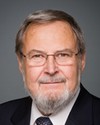Thank you, Madam Chairman.
On September 11, I was one of the few members of parliament who was here in Ottawa and on Parliament Hill. I saw firsthand, during the attacks on the United States, how unprepared our government was to protect those people on the Hill, whether they were tourists or whether they were workers.
By noon on September 11, airport landings in the United States had been halted. Planes in the air were being diverted to Canada. If terrorism was still in the air, it was coming to Canada.
In addition, President Bush had issued orders for the United States air force to shoot down any plane approaching Washington. It was only at 2.00 p.m., more than four hours after the crisis had begun to unfold, that the RCMP closed Parliament Hill to the public traffic, with barriers and guards.
From the perspective of countering terrorism, September 11 was not a day of which Canadians can be particularly proud. Today, though, is an opportunity to assess our weaknesses and make security improvements that are in the interest of both Canada and the world.
One such improvement was made by the president of the United States. President Bush appointed of Pennsylvania Governor Tom Ridge as head of their newly created office of homeland security, and in the words of President Bush, “to lead, oversee and co-ordinate a comprehensive national strategy to safeguard” the United States against terrorism.
I believe Canada must follow this lead in establishing a mirroring co-ordinated agency or ministry within Canada to act against international terrorism. The need for a co-ordinated effort is clearly evident for continental security.
Some approaches that might be explored by a homeland security ministry include the development of unconventional security analyses and recommendations. For example, we should upgrade the security credentials of all frontline airline workers, those responsible not only for security check-ins but the caterers, as well as ticket agents and customs workers. Airline personnel should be required to meet tougher new terrorist prevention awareness standards, standards that would be set internationally, possibly regulated through ISO 9001 standards or by Canadian General Standards Board, the CGSB. Presently, security scanner operators may be landed refugees with poor communications skills and only a work permit.
Other security strategies would include two. There is a danger of chemical and biological infiltration in airline cabins that can be met by electronic detectors, plus rapid emergency cabin air evacuation and repressurization to re-establish air quality. Flight deck security should be enhanced by armored integrated cabin doors. Flyby wire control conduits can be armour plated for security from explosive damage.
Additional measures and controls are numerous. Improved electronics could allow for flight plan lock-in to autopilot with limited release and range operation by pilots that would not allow an aircraft to be diverted without ground control release of security.
Plain clothes armed air marshals are an absolute necessity to keep in step with the threat reduction initiatives of other nations. The only issue to be debated should relate to the number of flight marshals and the percentage of flights that they should be present on, yet the Minister of Transport vehemently disagrees.
Also, another initiative could be that the flight recorders, the black boxes, should be improved to provide not just voice and digital data from the cockpit but also voice and video data from the cockpit and passenger cabin.
In addition to flight recordings with multiple point sound and visual sensors, there also should be concurrent transmission to ground of all air activities, sound and video. Obviously breaking technology would help address some of these proposals.
We have a choice. Better shared security over our continental perimeter with the United States or alternatively we will expose our great hitherto undefended international border to greatly hampered trade and tourism that will adversely affect our economy.
The starting point is to establish a mirroring homeland security ministerial office to work in step with the United States on continental security against terrorism.

